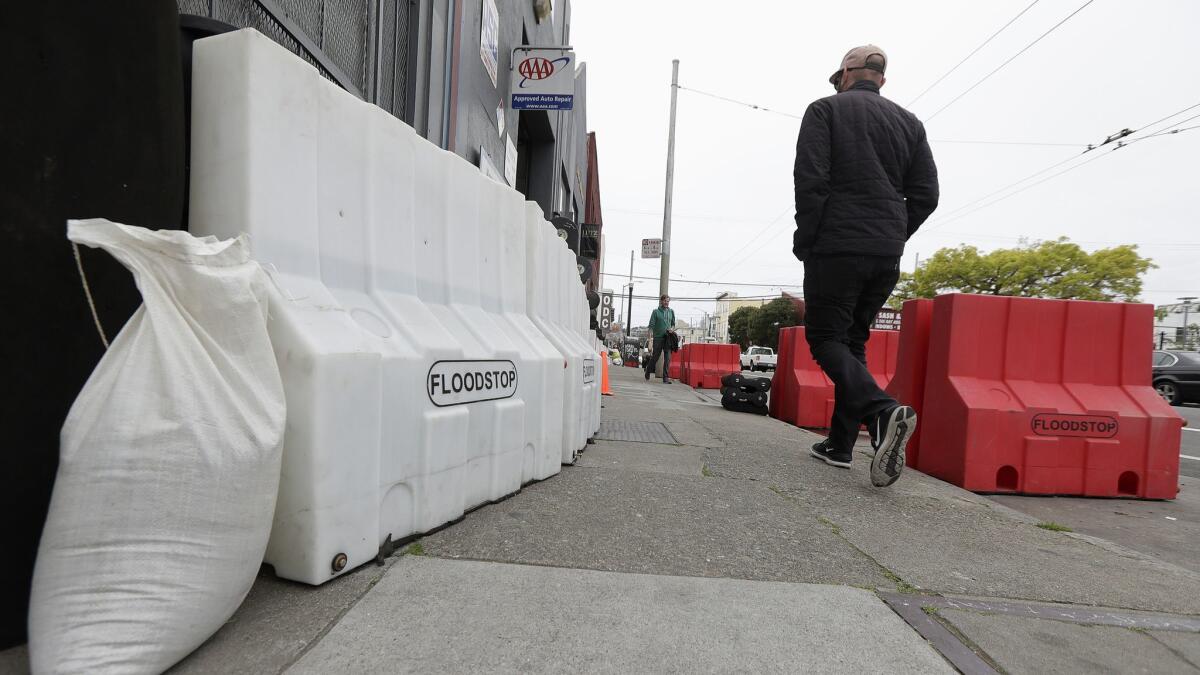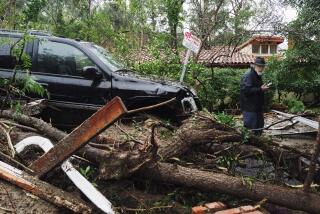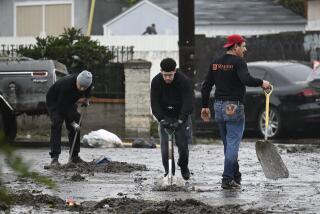Atmospheric river dumps rain across Northern California, flooding the Merced and Truckee rivers

A large tropical storm dumped rain over Northern California, drenching the Bay Area and causing some flooding in the Yosemite Valley and the Lake Tahoe area Saturday.
The Merced River reached its flood stage at 8 a.m., according to the National Weather Service. The storm that started Friday dropped more than 3 inches of rain in the Yosemite Valley, said Brian Ochs, a meteorologist with the weather service in Hanford.
The Merced River at the Pohono Bridge — which was running at about 4 feet ahead of the storm — hit 10 feet, which is when flooding occurs, Ochs said. The river was expected to rise to 15 feet by late Saturday, he said. The Merced River flooded last spring amid warm weather.
Yosemite Valley remained closed by the National Park Service on Saturday due to the flooding. All overnight reservations were canceled through Saturday night. Officials said they would reassess the situation on Sunday.
“There is some minor flooding in some of the campgrounds,” Ochs said. “Unfortunately it’s a loss of revenue for the park, but safety is the important thing.”
The main roads through the valley have been inundated with water, as has the Housekeeping Camp on the south bank of the Merced River, said meteorologist Kris Mattarochia with the weather service.
Video taken Saturday shows water flooding a roadway near the Yosemite Valley visitors center.
The rain was expected to taper off Saturday afternoon, but there remains a threat of mudslides in the Yosemite Valley due to recent wildfires, Ochs said.
The Truckee River also flooded early Saturday morning, according to the weather service.
The river reached its flood stage of 4.5 feet and is expected to crest at 5.7 feet Saturday afternoon, said meteorologist Courtney Obergfell. The flooding is expected to affect campgrounds, yards and basements of low-lying homes along the river, she said.
The “atmospheric river” storm — a long plume of water vapor pouring over from the Pacific Ocean — is loaded with warm tropical moisture that will accelerate snowmelt at some of the highest elevations along the northern and central Sierra Nevada.
San Francisco by early Saturday morning had recorded 2.22 inches of rain since the previous night, ranking it as the second-highest one-day total for the month of April. Parts to the north of the Bay Area got drenched by more than 6 inches of rain during the storm, according to the weather service.
Sacramento and Oroville broke daily records for rainfall Friday, and Santa Rosa saw 3.44 inches of rain from the storm. The storm forced a rare postponement of a game at San Francisco’s AT&T Park Friday, where the Giants had been set to host the Dodgers.
Officials with the California Department of Water Resources said they are closely monitoring how much water the storm sends into Lake Oroville, where a patched-up dam spillway may be used for the first time since last year.
At 2 p.m. Saturday, the lake level registered nearly 797 feet, well below the 901-foot-level at which it would spill over. If the lake rises to 830 feet, DWR officials said they will open the spillway gates, releasing water in a more controlled manner.
Current forecasts show the potential for runoff to raise the reservoir to near the 830-foot trigger elevation by the middle of next week, the department said.
The spillway is the reservoir’s primary tool for flushing out massive amounts of water in a quick, controlled way. It crumbled last year, triggering evacuations downstream, and has been only partially rebuilt, with engineers patching up the rest earlier this year. The remainder of the spillway is to be torn down and rebuilt after the current rainy season has passed.
Water resource managers have kept the lake well below its usual levels for the last year to avoid using the spillway amid repairs. But a string of late-season storms in March pushed the lake’s level higher.
The atmospheric river did not bring much rain to Ventura County or Los Angeles on Saturday, with light precipitation falling in the coastal mountains, according to the weather service.
Southern California appears poised to record one of the driest years on record, climatologist Bill Patzert said. Downtown Los Angeles since July 1 has received about 4.68 inches of rain, about 34% of what is seen on average by this time of year.
Follow @bposton on Twitter.
Times staff writers Joseph Serna and Rong-Gong Lin II contributed to this report.
UPDATES:
2:30 p.m.: This article was updated with information on flooding in the Yosemite Valley, rainfall amounts in Northern California and the status of Lake Oroville.
This article was originally posted at 10:45 a.m.
More to Read
Start your day right
Sign up for Essential California for news, features and recommendations from the L.A. Times and beyond in your inbox six days a week.
You may occasionally receive promotional content from the Los Angeles Times.







